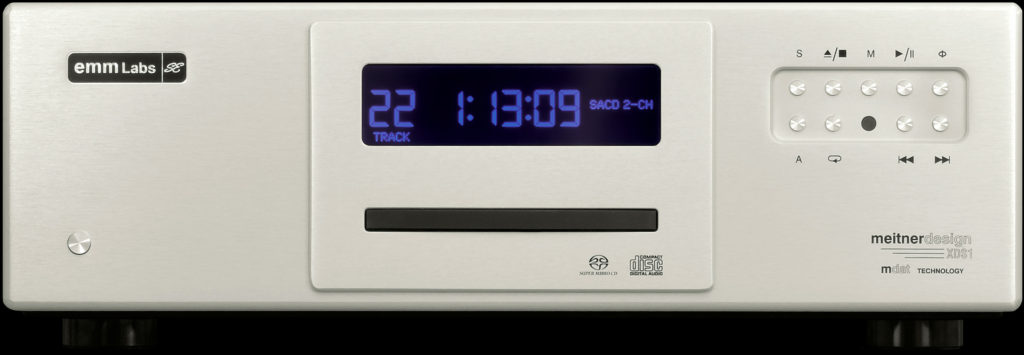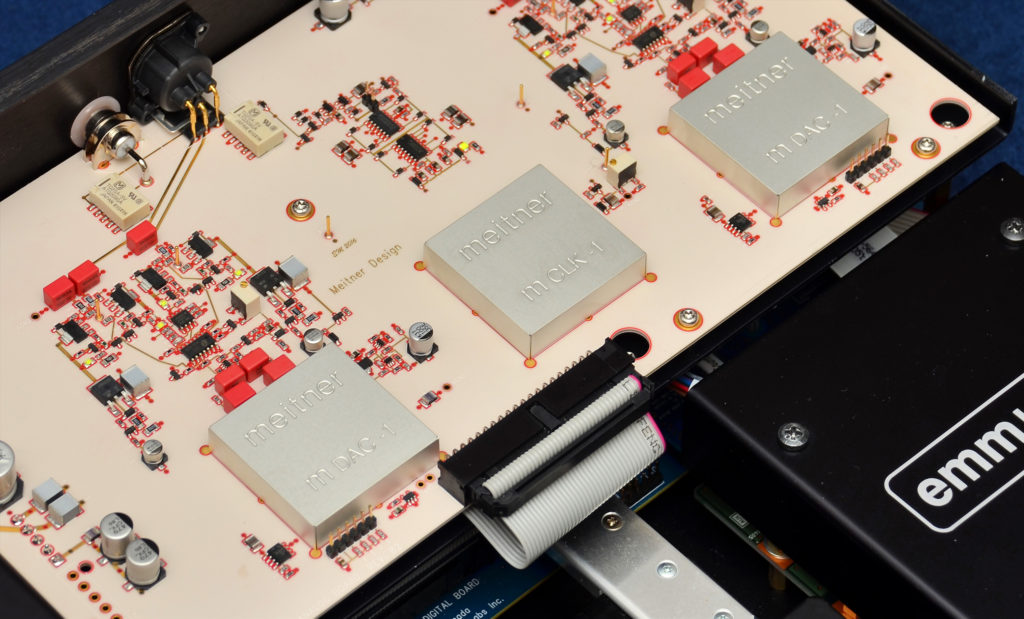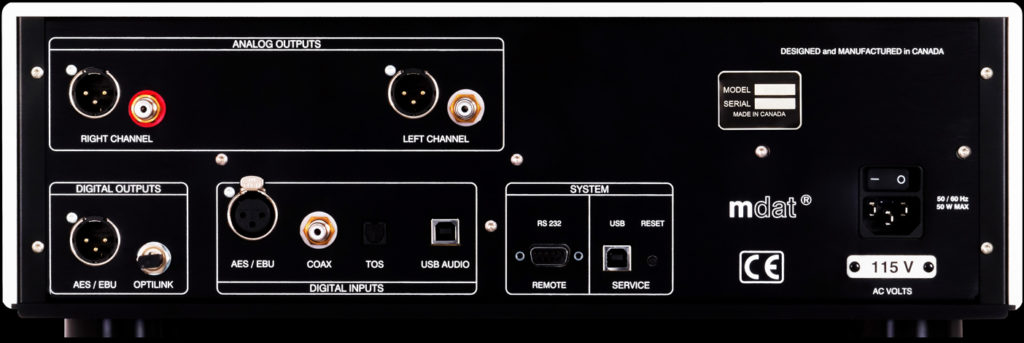Co-author: Earl Weed
The EMM Labs XDS1 SACD Player has now been in continuous production for ten years. It created a stir when released and has received many favorable reviews, including one from me. Unfortunately, technology never stands still and at some point, the XDS1 began to show its age. About two years ago, the company introduced a downloadable firmware update that again made the unit competitive with newer models from other manufacturers; however, Ed Meitner has never been one to be satisfied with any of his products as he is continually learning and re-thinking. Particularly, after the introduction of the groundbreaking EMM DA2, it became obvious that the performance of the XDS1 could be dramatically improved by a complete redesign of the unit.
I tend to think of Ed Meitner as primarily a digital visionary, forgetting that he is equally talented in the analog domain. A number of themes have emerged from his most recent work: 1) criticality of the analog stage of digital products (in Ed’s mind, this has been one of the areas of greatest improvement), 2) increasing the simplicity of the circuitry; and 3) decreasing settling time. The upgrade addresses each of these and incorporates much of what has been learned in the development of the DA2 digital to analog converter. As Ed explained to me, he included a fully-balanced single stage analog reconstruction of the digital signal, thus simplifying the process. He also improved the power supply regulation for the individual stages; the Esoteric OEM transport and switching power supply remain.
The review was based on extensive listening to an EMM XDS1 (v.2) followed by the V3 upgrade of that unit by Ed with subsequent listening in the same system. As a final check, the upgraded XDS1 V3 was compared to my digital reference, the current top-of-the-line EMM DA2/TX2.
The upgrade involves replacing the entire analog board that contains the DAC converter circuitry. Both the analog and converter circuitry are quite different than they were before, which is why it made sense to simply replace the entire board. A key component to the redeveloped board involves power distribution to both the analog and conversion circuitry — power distribution being an area in which there have been new learnings and developments in recent years in such sensitive areas. The changes in circuitry and power distribution represent nearly a decade of learning, and would be complex to describe specifically. As Ed Meitner said to me in a call, “It’s not just one tweak that gets us where we want to be…it’s a global thing. Everything has to play together. It is important to understand that the new board represents an overall process of continuing improvements, not just one thing.”
The end goal of the process is clarity, transparency, and musicality, the latter of which in this reviewer’s experience, sometimes seems to get left on the cutting room floor. After a month or so of very happy listening, I can sum up this upgrade simply: The upgrade is a terrific success and worth every penny for those who already have an XDS1.
Let me begin the listening descriptions with comments about a series of SACDs, from which one would expect excellence from EMM Labs.
First, the Analogue Productions’ reissue of RCA’s Charles Munch/Boston Symphony’s La Mer: This had sounded quite good previously; however, the update resulted in a step change: The instruments were further back behind the Acapella Triolon Excalibur in such a way that the speakers seemed to disappear more so than before. The detail was superb and the bass seemed particularly deep and full-bodied. The strings were clearly composed of a mass of individual instruments – an effect harder to come by previously. The clarinet and oboe solos were played on real-sounding, full-bodied instruments, which were well-positioned in image. In the flute solos, one could hear the player’s breath, as well as the sensuous tone of the flute. The soundstage was wide – wider than with the earlier iteration of the XDS1. The cellos, in the declamatory section at a bit before 5 minutes into the first movement, were exceptionally well-defined, the bows digging in with noted muscularity across the strings, singing out under Munch’s coaxing.
Next, Midnight Blue by Kenny Burrell, another excellent SACD by Analogue Productions with which I am also very familiar with its AP 45 RPM set. This recording is an object lesson in why the old Blue Notes have such a reputation albeit sometimes out of proportion, but not here.
In short, Kenny visited me in the room for a bit. His guitar – all left channel – was fully captured – the nuance of his attack, sometimes barely touching the strings with his pick, or slurring, or sometimes speaking out full-throated. I could not have asked for more. As good as the old XDS1 was, it could not quite capture this level of detail.
The cymbals, in the meantime were superbly defined. They were there, absolutely, but never aggressive, never overtaking the mix as they sometimes do; but just right where they needed to be. Indeed, the clarity and differentiation of instruments was so well done that I found myself listening to the congas with interest. I guess I’ve heard them before, I think I knew they were there; I think I’d heard them. But I heard them easily and clearly this time, and noticed what they added to the feel.
Next, let’s look at Miles Davis’s Bitches Brew, the Mo-Fi SACD. First, kudos to Mo-Fi for doing the SACD in the first place. It long ago needed doing. I’ve been listening to the Mosaic LP remaster in the last few years, and having a first class digital version is a fine thing, even if, ultimately, I’m not sure that the Mo-Fi quite stands up to the Mosaic LP, which is truly outstanding.
But, Mo-Fi’s SACD is very fine, and I like it better via the new version of the XDS1. Before this listening session, I’d felt that the Mo-Fi was just a bit muddy – not unlike how I recall the sound of the original LP (rightly or wrongly). With the new XDS1, the recording seems livelier, with a distinctly wider soundstage – much like the Mosaic LP – and with better definition of the instrumental groupings, which are a bit right/left in the mix. Again, the bass seemed deeper and more dynamic. I noticed the bass drum, which I hadn’t paid much heed to before. When the band came alive after the intro of Harvey Brooks’ electric bass statement of the title cut’s famous ostinato bass line, the darn thing rocked. I had to get up and dance around very subtly, so as not to frighten any poor outdoor critter that happened to be gazing in the window at the time – you’ve just got to forget critical listening every now and then, dammit – this is the fun stuff. Sure, sure, I could hear Miles whispering to the musicians in the softer passages, and Teo Macero’s famous tape splices (well-chosen, in fairness to ol’ Teo). But who cares – this is great music, and the XDS1 helped me get there.
One last SACD: Paul Hindemith’s Mathis der Maler from a BIS production. My main point here is this: My own impression of BIS’s recordings/SACDs is that they’ve sometimes seemed a bit bright to me, with an edge to the strings that would occasionally detract. I’m not sure if it is the level of resolution of the upgraded XDS1, or its voicing, or what, but I did not hear that here. While the BIS recording is not as naturally warm as, say, the RCA with Boston described above, there was no brittleness. The full orchestra in its intense moments in the Hindemith were fully controlled; powerful, but not unnaturally edgy in any way. When I think of the way the XDS1 handled this SACD, the word “fluent” comes to mind.
Indeed, this theme of “resolution trumping edginess” carries over to my first redbook CD listening description: Chris Connor’s Sings Lullabys for Lovers, a Japanese CD dub of Connor’s last Bethlehem record from the mid-50’s (Toshiba-EMI). This was a primo period for Connor, but the original LPs are virtually impossible to come by in tolerable condition. Although I still find the Toshiba version just a bit lacking in warmth, I enjoyed it more than with the earlier iteration of the XDS1. The detail within the 60-year-old mono recording is remarkable, as is the centering and intimacy of Connor’s voice. Something to do, perhaps, with those old Neumann mics?
A go-to demo CD for some of my listening buddies and me recently has been David Sylvian’s double disc set, Everything & Nothing, in particular the longish (for a pop-type tune, if Sylvian can be considered to fit in that mold) track, I Surrender, number 13 on Disc 1. Sylvian’s voice is startling in its presence. You hear everything that went into the mic. And the strings, mainly cellos and basses until partway through the track are – as with the RCA/Boston recording – clearly a string section, with individual players forming a unit. And again, you can hear the buzz of the bow as they intensify…which is also very well-portrayed dymanically.
The bass drum is palpable and solid in a way that I do not recall, and the overall image goes deeper behind the speakers. Kenny Wheeler’s lyrical trumpet toward the end speaks from a slight distance back, his beautiful trumpeter’s voice bell-clear but warm, all through his amazing range.
The gap between analog and digital has troubled me for a long time and even increasingly so as better amplifications revealed the seriousness of the gap. The previously reviewed EMM Labs DA2 was a game-changer as it narrowed the gap considerably.
In its price range, the updated XDS1 is, as well. The sound is cleaner, the instruments more clearly living in their own spaces, the depth and air more clearly delineated. Bass is deeper, more full-bodied, even richer, though fully dynamic and punchy. Yet, all of this is in the service of the musical presentation. Stated simply, I, and my listening friends who sampled some of these cuts with me, experienced the music more fully than we had before.
In terms of comparing the updated XDS1 with the previous iteration, let me put things into perspective. Years ago, I really enjoyed the EMM CDSA. It was a terrifically musical unit at the time, but I hadn’t invested in an EMM Labs gear yet until the XDS1, and now I own the TX2 and DA2 as my digital reference. Retrospectively, the DA2 was the one that pushed me over the edge because with it, I began listening to digital more than ever before, and when my turntable was down awaiting a new compressor for several weeks, I was surprised to find myself listening to digital in such a way that – while not forgetting my treasured vinyl – I was really pleased to hear some new things that I will not likely ever hear on vinyl.
I find the updated XDS1 to represent a step change over the previous unit. The DA2 provides more of the same and remains a step change over the updated XDS1, and is priced accordingly. EMM Labs has been offering the XDS1 for ten years now, and technological advancements developed during these years matter. The original XDS1 is still very good but if I were still using an XDS1, I would unhesitatingly update it.
This review would have been difficult, if not impossible, without the cooperation of my long time listening friend Earl (“the evil”) Weed who provided his EMM XDS1 for the update and was then kind enough to allow me to listen to the unit in my system for over a month during which time he spent many evenings with me listening and providing insights with respect to the differences. Subsequently, we reinserted the XDS1 into Earl’s system and did additional listening, which reinforced my conclusions.
- (Page 1 of 1)




I have the second version of this machine and love it!
Thank you!
What rates are supported by the upgrade? Ie is it the same as the DA2 rates?
Hello Fred ,
Enjoyed the review. Are emm labs products using a spartan FPGA with just custom code? Or are these chipsets by entirely by emm themselves and or by 3rd party to their specification ?
Would like to see how this compares to the newer Esoteric K1 player?
This is performance update and not a function update. So nothing changes with regards to supported sample rates. With respect to the second question, it is a combination of custom FPGA and proprietary discrete DAC all produced in-house. No third party products are used. As I noted in the article, while this is a stunning upgrade, there are still differences between it and the more expensive DA2, both respect to the firmware and the speed of the processor; however, EMM has been successful in delivering much of the performance of the TX2/DA2 in a single box unit at approximately half the price. If you own an XDS1, I wholeheartedly recommend that you consider the upgrade.
Thanks for the insightful review.
– do you have any experience with the unit as an external DAC?
– can you compare with any other dacs in the price range? Specifically interested vs the PS Audio DirectStream FPGA dacs.
Thanks!
Thanks for your kind note J. Yes, the XDS1 V2, and V3 especially, can be used as a DAC via the digital inputs, USB Audio, TOSLINK, SPDIF and AES.
All inputs support up to 24bit 192kHz. The USB Audio input additionally supports DSD via DoP streaming as well. You can use any of the digital inputs to connect to your digital audio source. If using a computer, it is best to us the USB Audio input for greatest flexibility. Using MAC or OSX you don’t need any drivers just plug it in and play. If you are using Windows computers you will need to install the USB 2.0 audio drivers supplied here:
http://www.emmlabs.com/images/products/software/EMM_Meitner_3.3_Driver_June_2016.zip
While I have not made comparisons with the DAC you mention, I can say that the performance of the updated XDS1 is very close to the best available when cost is no object.
Fred
I’d like to upgrade the CDP XDS1 V2 to V3, pls. kindly informed me the phone no and email so that we can buy module v3. I live in Vietnam country.
Dear Vuong,
Thank you for your readership and comment. Shahin Al Rashid of EMM Labs sent the following to us in response to your inquiry:
“Please take it back to the dealer from whom he purchased the XDS1 V2 for the upgrade. If not, he can send email to support@emmlabs.com or just email me directly (shahin@emmlabs.com) with his XDS1’s serial number. The unit can then be sent back to us directly for the upgrade if he does not have a dealer in his area.”
I would be interested in how the upgrade is coming along. Please send us a word when it is done. We look forward to hearing from you.
Constantine Soo
Dear Constantine Soo,
Thank you for your information. After contacting Mr Shahin – Emm labs Inc., I sent my unit to them to upgrade to V3. I am satisfied.
Thank you!
bạn có cho tôi biết cách phân biệt cdp xds1 v1,xds1 v2, xds1 v3 ,vì tôi đang muốn mua 1 trong 3 sản phẩm của bên bạn,xin cảm ơn, tôi ở việt nam
Google Translate: Can you tell me how to distinguish cdp xds1 v1, xds1 v2, xds1 v3, because I want to buy 1 of your 3 products, thank you, I’m in Vietnam